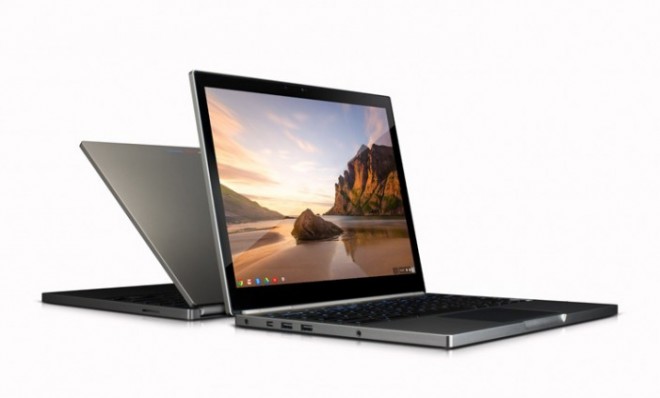The 5 biggest problems with Google's Chromebook Pixel (and what to buy instead)
Why pay $1,300 for a pretty web-browsing machine?

On Thursday, Google surprised everyone by revealing a new laptop — the Chromebook Pixel. At face value it's an impressive piece of hardware. Its sturdy aluminum body looks like a MacBook Pro. Its pixel density (239 pixels per inch) gives it ultra-sharp HD to rival any Retina display. And, in addition to a touchpad, the Pixel's screen responds to touch — swipes, pinch-to-zooms, and other gestures are all there. The message is clear: Google is now in the laptop business.
And yet, for all the glowing praise heaped on the Pixel by its design team, the device still faces an uphill fight if it hopes to compete with the MacBooks and Ultrabooks of the world. Here's why Google's Pixel, as it stands, is a product you should stay away from:
1. It's way too expensive
The Week
Escape your echo chamber. Get the facts behind the news, plus analysis from multiple perspectives.

Sign up for The Week's Free Newsletters
From our morning news briefing to a weekly Good News Newsletter, get the best of The Week delivered directly to your inbox.
From our morning news briefing to a weekly Good News Newsletter, get the best of The Week delivered directly to your inbox.
Other Chromebooks are great additions to households that already have a main computing rig. (We have one underneath the coffee table.) They're astonishingly inexpensive — Samsung's WiFi-only model is just $249 on Amazon, or as cheap as a Nexus 7 — and they let you browse the web, watch YouTube clips, check your email, and do some light document editing in Google Docs. Stuff you do 70 percent of the time on a normal laptop anyway.
That's what makes the Pixel's asking price so puzzling: $1,300 for a WiFi-only Pixel when it goes on sale next week, and $1,450 with LTE when it ships in April. Same functionality trade-offs as other Chromebooks, five times the price. A 13-inch MacBook Pro with Retina display is $1,499, and lets you run Microsoft Office, iTunes, Photoshop, iMovie, Spotify, StarCraft II, and whatever else your heart desires. Aside from a few select Chrome apps, the Pixel's only piece of real software is, well, Chrome. The math doesn't add up.
2. Most of the web isn't optimized for HD
The Pixel's display is beautiful. Google says that by cramming in 4.3 million pixels, the screen "offers sharp text, vivid colors, and extra-wide viewing angles." That's great. But right now, the the vast majority of the web simply isn't optimized for ultra-sharp high definition, which is a problem if your main portal for doing things is Chrome OS. It's like buying a brand-new Porsche 911 for the sole purpose of off-roading.
A free daily email with the biggest news stories of the day – and the best features from TheWeek.com
3. Most of the web isn't optimized for touch
Another sad fact is that the internet isn't optimized for touchscreens. That's why half-baked mobile editions exist for websites in the first place. Granted, poking around on tiny hyperlinks is monumentally easier on a tablet or a device like the Microsoft Surface that you can hold steady with both hands, but the Chromebook still has the size, shape, and dimensions of a clunky laptop. Yes, touchscreens will be on every new high-end computer within a year and a half, and they'll be great for editing photos, juggling windows, and feeling like you're Tony Stark in Iron Man; unfortunately, though, the Pixel's limited capabilities make it hard to do any of that.
4. Its battery life is horrid
The Pixel's spec sheet promises "up to five hours of active use" between charges. Most tablets promise anywhere from nine to 10 hours. That means the Pixel won't even last you the duration of a cross-country flight from New York to Los Angeles — if your plane even has WiFi to begin with.
5. You only get three years of free storage
Google is offering Pixel buyers an unprecedented 1 terabyte of cloud storage for three years. The catch — and it's a big one — is that after those three years, you're paying $50 per month to keep photos, GIFs, or whatever else you right-click on stored in Google's cloud. That's a lot of money if you don't plan on buying a replacement within that three-year window.
BONUS
Instead of the Pixel, you could buy one of these comparable devices and do all the things the Pixel does (and more) for a cheaper price:
• Samsung's 11.6-inch Chromebook ($250)
• Google Nexus 10 ($399)
• Lenovo IdeaPad Yoga 13 ($1,049)
• Microsoft Surface Pro ($899)
• Apple's 13-inch MacBook Air ($1,199)
-
 One great cookbook: ‘More Than Cake’
One great cookbook: ‘More Than Cake’the week recommends The power of pastry brought to inspired life
-
 Democrat files to impeach RFK Jr.
Democrat files to impeach RFK Jr.Speed Read Rep. Haley Stevens filed articles of impeachment against Health and Human Services Secretary Robert F. Kennedy Jr.
-
 Constitutional rights are at the center of FBI agents’ lawsuit
Constitutional rights are at the center of FBI agents’ lawsuitIn the Spotlight The agents were photographed kneeling during a racial justice protest